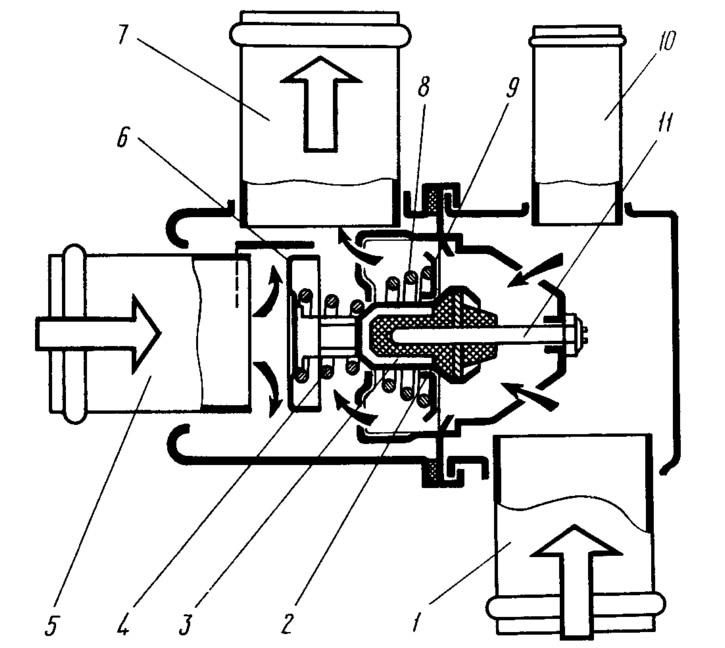Thermostat (pic. 35) consists of a body and a cover, which are rolled together with the seat of the main valve 9. The thermostat has a branch pipe 1 for the inlet of cooled liquid from the radiator, a branch pipe 5 for the liquid bypass hose from the cylinder head to the thermostat, a branch pipe 7 for supplying coolant to the pump and a branch pipe 10 for the expansion tank hose.

Pic. 35. Thermostat:
1 - inlet pipe (from the radiator); 2 - rubber insert; 3 - solid thermosensitive filler; 4 - additional valve spring; 5 - inlet pipe (from the engine cooling jacket); 6 - additional valve; 7 - outlet pipe (to the pump); 8 - main valve spring; 9 - main valve; 10 branch pipe (from expansion tank); 11 - piston.
The main valve is pressed into a glass, in which a rubber insert 2 is rolled. This insert contains a polished steel piston 11, fixed on a fixed holder. Between the walls of the cup and the rubber insert 2 there is a heat-sensitive solid filler 3. The main valve 9 is pressed against the seat by the spring 8. Two racks are mounted on it, on which a bypass valve 6 is installed, pressed by a spring 4.
The thermostat, depending on the temperature of the coolant, automatically turns on or off the radiator of the cooling system, passing liquid through the radiator or bypassing it.
On a cold or not warm enough engine at a coolant temperature below 87°C, the main valve 9 of the thermostat is closed, and the bypass valve 6 is open (the temperature value is indicated on the bottom of the thermostat). The coolant, circulating from the engine cooling jacket through the thermostat bypass valve, is sucked through the hose and inlet pipe 19 (see fig. 31) pump 16 and again fed into the cooling jacket (small circle), bypassing the radiator. This ensures that the engine warms up quickly.
If the temperature of the liquid is above 102°C, the solid filler of the thermostat expands, compresses the rubber insert and pushes the piston out. In this case, the main valve opens completely, and the bypass valve closes completely. The liquid will circulate from the engine cooling jacket through hoses 3 and 5 through the radiator to thermostat 25, then through the main thermostat valve through hose and tube 19 to the pump and cooling jacket (great circle of circulation). In the radiator, the liquid is cooled by air flow. When the liquid temperature drops, the electric fan is automatically turned off by sensor 8 installed in the radiator tank.
Within the temperature range of 87...102°C, the liquid circulates both in a large circle and in a small one, since the thermostat valves are in intermediate positions. An increase in the opening of the main thermostat valve leads to a gradual increase in the supply of liquid cooled in the radiator and maintaining the optimum thermal regime of the engine.
